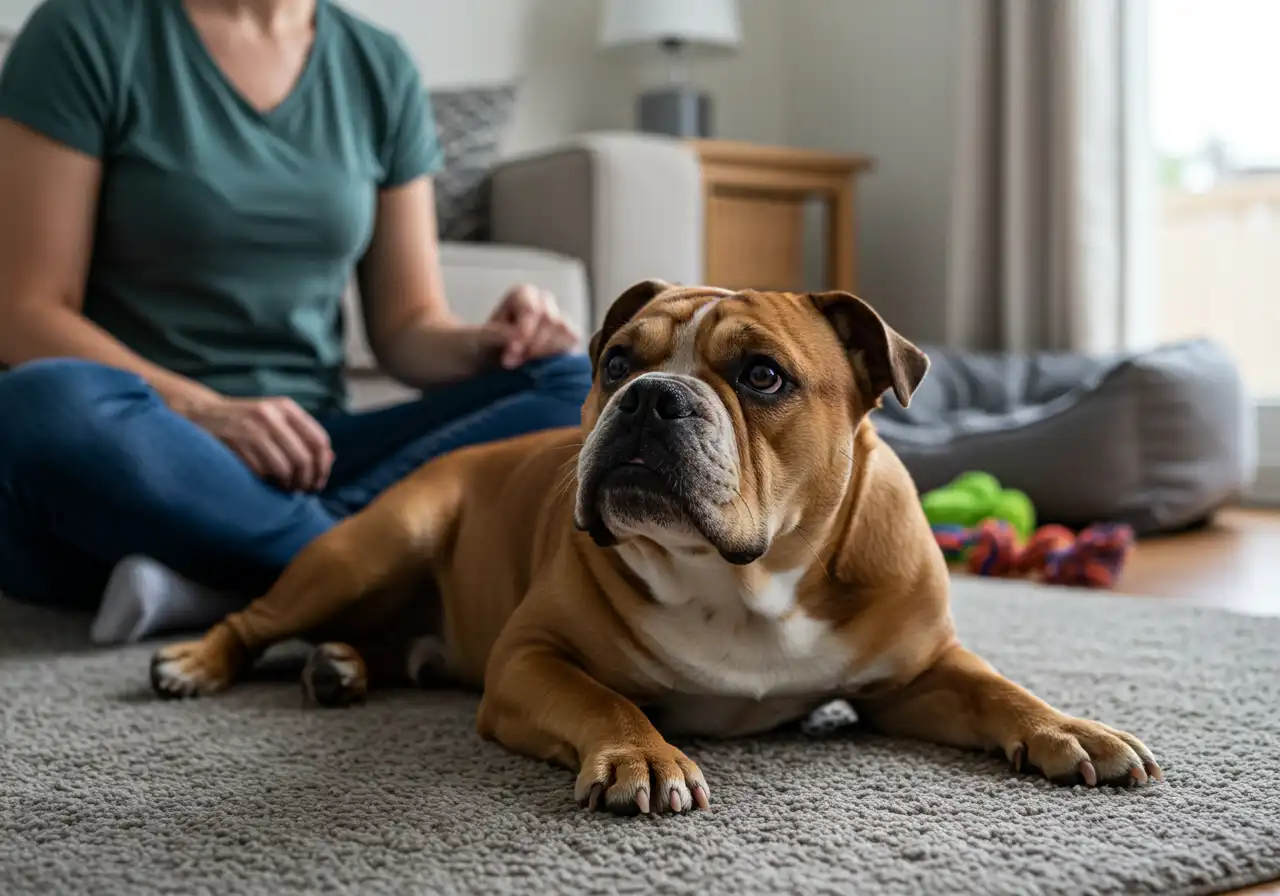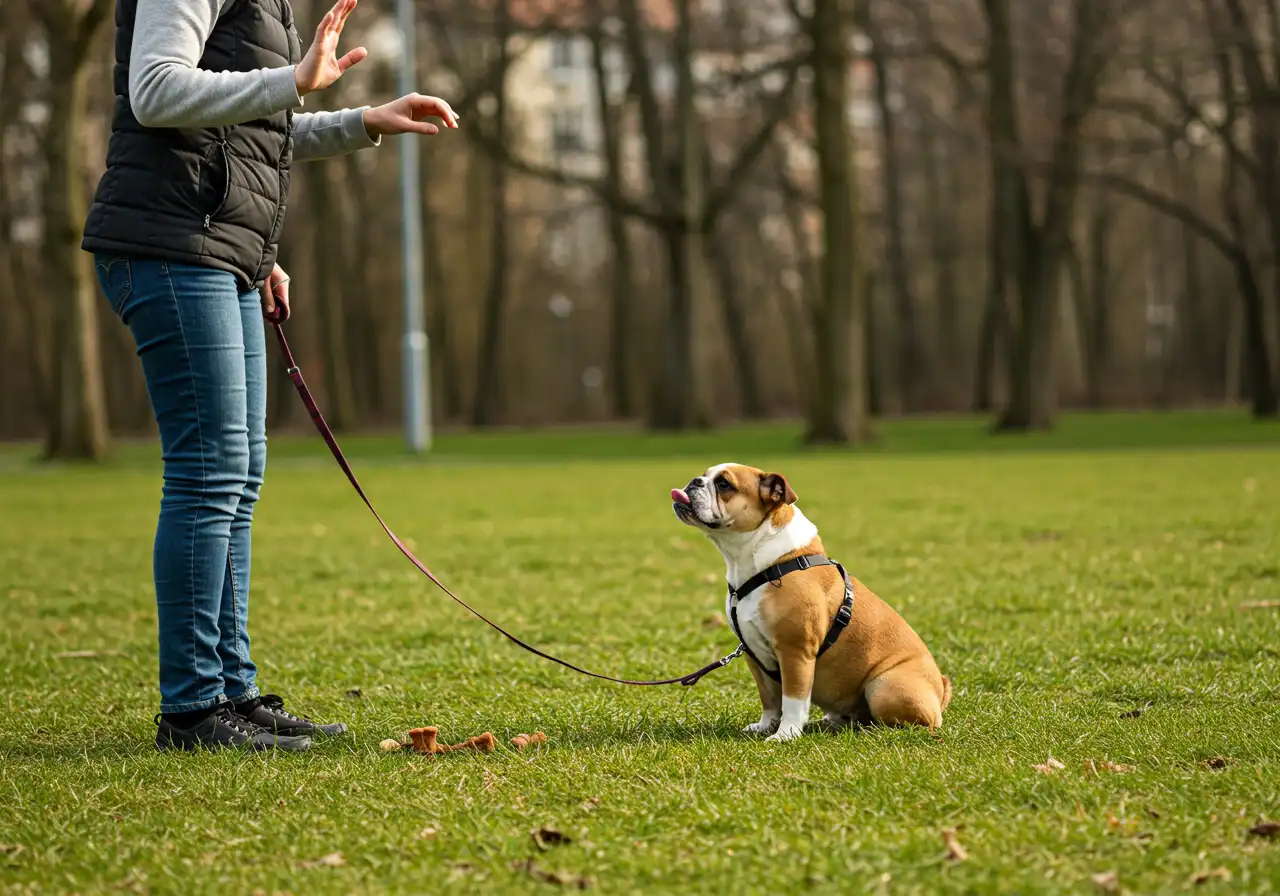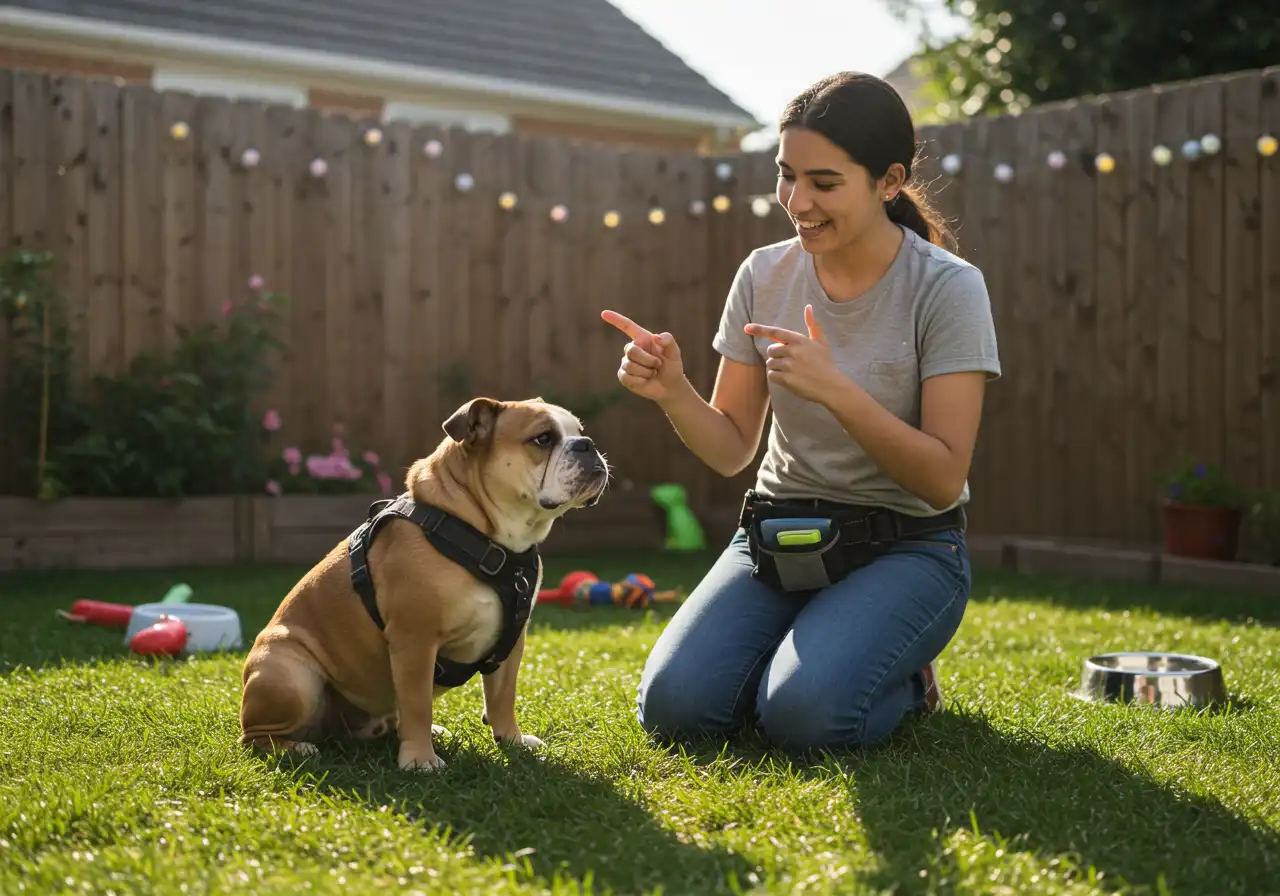Raising a bulldog for the first time comes with its own set of challenges that make these dogs different from others. Bulldogs, including popular types like French Bulldogs, have strong personalities and can easily become the leaders of the household if rules aren’t set early on. As a new bulldog owner, it’s crucial to understand the importance of structure and leadership.
Why training basics are important:
- Bulldogs do better when they know who is in charge—being the leader stops confusion and behavior problems.
- Basic commands like sit, come, down, stay, and leave it are essential for good behavior, safety, and respect.
By consistently training your bulldog and setting clear rules, you’ll not only manage their behavior better but also build a stronger bond with them.
This blog about “Training Basics for First-Time Bulldog Owners” begins with a promise to maintain structure and communicate clearly. This method leads to having a calm and well-behaved pet.
Understanding Bulldog Behavior
Bulldogs are pack animals by nature. This instinct drives them to seek structure and a clear sense of hierarchy in their environment. Without a defined leader, a bulldog may attempt to fill the leadership role itself, leading to unwanted behaviors and confusion about boundaries.
Establishing Yourself as the Leader
- Bulldogs respond best when they recognize you as the decision-maker in the household.
- Leadership does not mean intimidation; it’s about calm confidence and consistent guidance.
- Setting rules and enforcing them teaches your bulldog that you control resources—food, toys, walks—making your leadership clear without harshness.
Common Behavioral Issues in Bulldogs
Several behavioral challenges can arise if leadership is not established early:
- Stubbornness: Bulldogs are notorious for testing boundaries when they sense inconsistency.
- Resource guarding: Lack of clear leadership may prompt a bulldog to guard food or toys. This behavior can be particularly problematic, but understanding its roots can help in treatment and prevention.
- Excessive barking or jumping: These attention-seeking behaviors often stem from unclear rules or an absent authority figure.
Effective leadership prevents these issues before they start. Clear expectations, consistent routines, and immediate correction of unwanted behavior help your bulldog feel secure and respect your role as the pack leader.
Understanding bulldog behavior sets a foundation for every interaction you have with your new dog. Recognizing their need for structure improves both training outcomes and your daily life together.

Introducing a New Bulldog to Its Home
Bringing a new bulldog puppy into your household marks the start of a unique relationship. Bulldogs respond best to environments that are calm, structured, and predictable. The way you introduce your bulldog to its new home sets the foundation for trust and security.
Step-by-Step Guide for a Calm Introduction
- Prepare the Environment
- Remove hazards and secure any loose items.
- Set up a designated area with a cozy bed, water bowl, and some safe toys.
- Introduce family members one at a time in a quiet, gentle manner.
- Arrival at Home
- Carry your puppy inside or let them walk on a leash—avoid rushing or loud greetings.
- Allow the puppy to explore their space at their own pace.
- Keep voices low and movements slow during these first moments.
- Minimize Stimulation
- Avoid having guests over for the first few days.
- Limit interactions with other pets until your bulldog feels comfortable.
- Prevent overstimulation by keeping TV and music volume low.
- Feed meals at consistent times.
- Begin bathroom breaks on a schedule.
- Use the same door for walks to build familiarity and reduce confusion.
Calm introductions help prevent stress in your new bulldog puppy. Stress prevention is crucial; anxious puppies can develop unwanted behaviors or attachment issues. Small steps, repeated consistently, create an environment where your bulldog can relax and learn.
A welcoming environment starts with patience. Gentle guidance as your puppy explores their new territory helps reduce confusion and builds their confidence in you as the leader. A calm introduction ensures your bulldog begins life in their new home feeling safe, secure, and ready for training routines ahead.

Basic Obedience Training for Bulldogs
Obedience training lays the groundwork for a respectful relationship between you and your bulldog. Establishing control and structure with basic commands not only keeps your dog safe but also reduces unwanted behaviors that can stem from confusion or insecurity.
Essential Commands Every Bulldog Should Learn
1. Sit
Teaching “sit” helps curb jumping, teaches patience, and gives you a starting point for more advanced training.
- Hold a treat close to your bulldog’s nose.
- Move your hand upward, allowing their head to follow the treat, causing their bottom to lower.
- Once they’re in a sitting position, say “sit,” give the treat, and offer praise.
2. Come
The “come” command is vital for safety—especially in distracting environments.
- Start on a leash in a quiet space.
- Gently pull the leash as you crouch down, using an enthusiastic voice: “Come!”
- Reward immediately when your bulldog reaches you.
3. Down
“Down” encourages calmness and submission, especially useful with excitable puppies.
- With your bulldog sitting, hold a treat near their nose and move it slowly to the ground.
- As they follow, gently slide the treat forward so they lie down. Say “down,” reward, and praise.
4. Stay
This command builds self-control and keeps your dog out of trouble during daily life.
- Ask your bulldog to “sit” or “down.”
- Open your palm toward them and say “stay.”
- Take a few steps back; if they remain still, return and reward. Gradually increase the distance over time.
5. Leave It
“Leave it” prevents dangerous or unwanted interactions with items or food on walks or at home.
- Place a treat in both hands. Show one closed fist with the treat inside; say “leave it.”
- Ignore attempts to get the treat. Once they stop trying, reward with the other hand’s treat.
How Obedience Training Enhances Behavior
Basic obedience commands provide mental stimulation and establish clear expectations. When you use these commands consistently:
- Your bulldog learns boundaries and respects household rules.
- Decision-making becomes easier for your dog—they look to you for guidance rather than acting out of uncertainty.
- Structured training sessions deepen trust and communication, reducing the likelihood of stubbornness or disobedience.
Obedience training is not just about teaching tricks—it’s about building mutual respect and making daily life smoother for both you and your bulldog.
“Training Basics for First-Time Bulldog Owners” emphasizes patience, repetition, and positive reinforcement at all times. Each session should be short but focused—bulldogs respond best when lessons are clear and consistent.
Effective Training Techniques for Bulldogs
Effective training techniques are essential for ensuring your bulldog remains focused and engaged during training sessions. One crucial aspect of successful training is managing your bulldog’s energy levels.
Bulldogs, like all dogs, need to have their physical and mental energy expended appropriately before they can focus on learning new commands or behaviors. Unspent energy can lead to distractions, hyperactivity, and a lack of concentration during training sessions.
Tips for Expenditure of Excess Energy:
- Walks: A brisk 20-30 minute walk before training can help burn off excess energy. This allows your bulldog to settle down and be more receptive to commands.
- Playtime: Engaging in interactive play with toys such as balls or tug ropes can provide both physical exercise and mental stimulation.
- Mental Stimulation: Puzzle toys or treat-dispensing games can challenge your bulldog’s mind and keep them occupied.
By incorporating these activities into your routine, you ensure that your bulldog is neither too energetic nor too tired during training sessions. Balancing their energy levels fosters a conducive environment for effective learning.
Training sessions should be concise, typically lasting no longer than 10-15 minutes. Keeping sessions short ensures that your bulldog remains attentive and does not become bored or frustrated. Positive reinforcement techniques, such as treats, praise, and affection, should be used consistently to reward desired behaviors.
Key Points to Remember:
- Manage energy levels through walks, playtime, and mental stimulation.
- Keep training sessions short and engaging.
- Use positive reinforcement to encourage good behavior.
These effective training techniques will help you maintain control and build a strong bond with your bulldog, ensuring a well-behaved companion.
The Role of Consistency in Bulldog Training
Consistent training is crucial for effective bulldog behavior management. Bulldogs do best when they understand exactly what is expected of them; mixed signals or changing rules can confuse them and lead to stubbornness or boundary testing. When you establish clear limits and enforce them every time, your bulldog learns that rules are not up for discussion.
Why Consistency Matters:
- Bulldogs respond best to predictable routines and expectations.
- Repetition helps your dog internalize commands and understand consequences.
- Inconsistent correction for unwanted behaviors can reinforce bad habits, as the dog may gamble on whether a certain action is allowed.
Practical Strategies for Consistent Training:
- Use the same verbal cues and hand signals for each command. If you teach “down” one day but say “lie down” the next, your bulldog may not connect the dots.
- Establish household rules early—decide if the dog is allowed on furniture or where feeding areas are, and stick with those choices.
- Correct unwanted behaviors immediately and every time they occur. If you ignore jumping up sometimes but scold it others, the message gets lost.
- Ensure all family members are on the same page with training techniques and boundary setting. Conflicting instructions from different people can undermine progress.
Maintaining consistent training habits sets your bulldog up for long-term success, providing security and clarity about their role within the home. This strong foundation creates a smoother path toward integrating exercise and mental stimulation into daily routines.
Exercise, Mental Stimulation, and Training Synergy
Bulldogs thrive when their bodies and minds are both engaged. Regular exercise supports not only your bulldog’s physical health but also helps manage energy levels, making them more receptive to training. Without adequate physical activity, bulldogs often become restless or display unwanted behaviors such as chewing, digging, or barking.
Mental stimulation is just as essential as physical exercise. Bulldogs are intelligent and benefit from activities that challenge their problem-solving skills. Mental enrichment prevents boredom and reduces the likelihood of destructive behaviors rooted in frustration.
Ways to combine exercise, mental stimulation, and training basics for first-time bulldog owners:
- Daily Walks: Consistent walks offer both exercise and opportunities to reinforce obedience commands like heel or sit at street corners.
- Interactive Toys: Puzzle feeders or treat-dispensing toys keep your bulldog mentally sharp while encouraging patience and focus.
- Short Training Sessions: Practice basic commands in different environments—inside the house, backyard, or during walks—to keep your dog alert and responsive.
- Playtime with Structure: Games like fetch or tug-of-war can include drop it or stay commands to blend play with obedience work.
Bulldogs need a balance of movement and mental engagement. Skipping either often leads to training setbacks and behavioral issues.
Introducing variety into daily routines ensures your bulldog receives the right mix of activity and challenge. This approach forms the foundation for a well-adjusted dog who responds positively to instruction and structure.
Conclusion
Bulldog ownership tips emphasize the importance of structure, leadership, and commitment. Establishing yourself as the “alpha” ensures your bulldog respects boundaries and follows commands. Consistent training and clear rules help prevent behavioral issues.
Key points to remember:
- Structure: Create a routine that includes regular exercise, training sessions, and mental stimulation.
- Leadership: Assert your role as the pack leader through calm and confident behavior.
- Ongoing Commitment: Training is a continuing process; consistency and patience are essential.
By following these training basics for first-time bulldog owners, you foster a strong bond with your dog and create a harmonious household.

